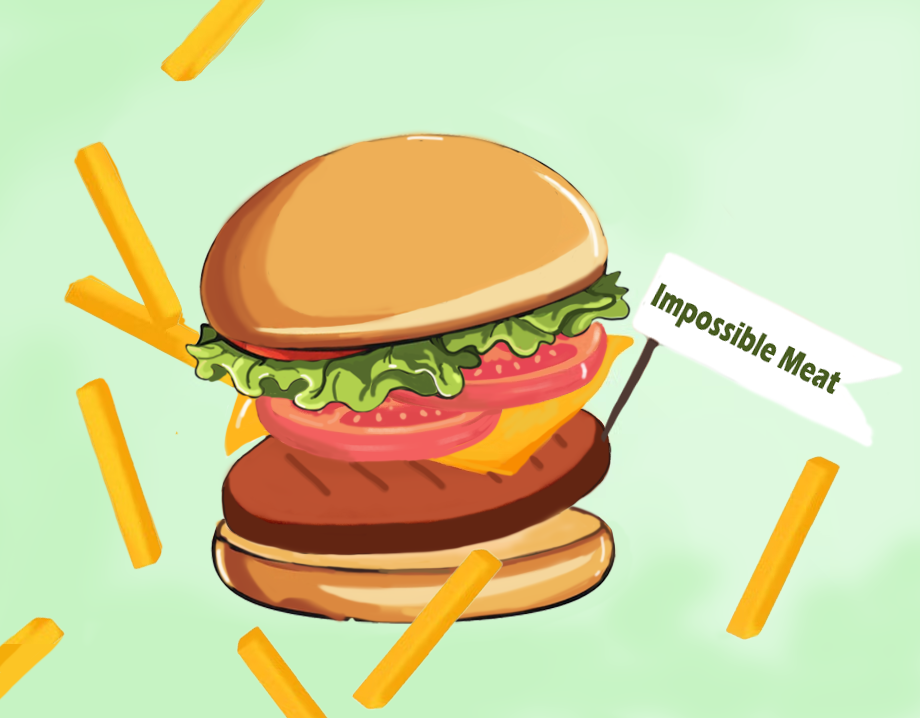
It’s hearty; it’s flavorful. It’s crispy on the outside but juicy on the inside. It sits between two halves of a Brioche bun interrupted by layers of lettuce, tomatoes, onions, pickles, and a suspiciously yellow slice of cheese. And when you sink your teeth in, you taste the unmistakable savoriness of what you’d never think was soy protein. Nothing speaks more to Yankee classics than the beef patty burger, but the beginning of “Impossible” foods reveals yet another facet of American innovation and discovery.
Though meats are a staple in many diets, bringing animal products from farm to table is costly for the environment. According to Vox, cultivating livestock contributes to about fifteen to twenty percent of greenhouse emissions due to the rigorous use of farmland in growing corn to feed the animals, leading to deforestation that is also intensified by grazing (2024). Furthermore, significant amounts of freshwater are depleted in raising animals–nearly ⅓ of the world’s supply (United Nations Climate Change, 2019). Namely, meat consumption continues to push Earth’s biodiversity, and it is an increasingly unsustainable practice because of its immense use of natural resources and release of greenhouse gases, mainly methane, into the atmosphere.
To combat this threat to Earth’s ecosystems, scientists have begun to develop environmentally-friendly alternatives to meat to aid vegetarian diets. Arguably the most notable, Dr. Patrick O. Brown’s Impossible Foods Inc. has used genetic modification and biochemistry to develop beef substitutes since 2011, e.g., the Impossible Burger. His final goal is “to be able to reproduce the biochemistry that produces flavor in meat,” believing that engineering a plant-based protein’s normal function in a cow is second to replicating the taste of beef (American Society for Microbiology, 2019). Ultimately, his team was able to achieve this effect through “farming” the soy protein leghemoglobin–a naturally occurring molecule of iron derivatives–from a yeast named Pichia pastoris to create a meat-free beef slider.
In creating this indiscernible replica of beef, Impossible Foods’ environmental impact is manifested through the usage of “96% less land, 87% less fresh water,” and the generation of “89% less greenhouse gas emissions” than when farming cows (United Nations Climate Change, 2019). Thus, Impossible Foods Inc. has inaugurated a period of environmentally friendly eating and introduced a new market for plant-based foods–as of 2024, the company sells sausage, chicken, meatballs, and pork in addition to beef. From one product alone, the company was able to transform the American food system from production to consumption and significantly reduce the driving factors of climate change.
Others, however, note that despite the apparent prosperity of plant-based proteins, fruits and vegetables are still contributors to the rising climate crisis. For example, growing a single avocado tree requires about “46 gallons [of water] every day in the summer” in regions like California and Mexico, where avocado production is abundant, but water is scarce (BBC, 2020). Though less environmentally taxing than raising animals, growing plants also serves as a stressor for local populations. So, it is important to account for one’s net carbon footprint in food consumption while acknowledging the ecological benefits of going plant-based.
The possibilities of Impossible Foods span from reducing the world’s carbon footprint and transforming the nation’s supermarkets to raising societal concern on what was a previously overlooked part of one’s lifestyle–the diet. Going plant-based continues to be controversial, and companies like Impossible Foods ask Americans: do you really miss the meat? Despite being given the option of a nutritious, environmentally friendly, and equally-tasting protein, many continue to choose animal meat. Some do so to evade processed foods, while others do so because of moral reasoning. So, though engineered foods may showcase the progress of American food science, they remind the nation of a core American tradition. We have the liberty to choose what we produce and consume, and that might include a delicious, climate-change-reducing burger for some.
References
Gray, R. (2023, February 13). Why the vegan diet is not always green. British Broadcasting Corporation. Retrieved June 12, 2024, from https://www.bbc.com/future/article/20200211-why-the-vegan-diet-is-not-always-green
Letters: Warning: veganism can be very dangerous for the planet. (2023, June 26). Herald [Glasgow, Scotland], NA. https://link.gale.com/apps/doc/A754719967/GIC?u=san00962&sid=bookmark-GIC&xid=16dbc652
Torella, K. (2024, March 20). The next big climate deadline is for meat and dairy. Vox. Retrieved June 12, 2024, from https://www.vox.com/future-perfect/2024/3/20/24105735/peak-meat-livestock-emissions-plant-based-climate-deadline
United Nations Climate Change. (n.d.). Impossible Foods: Creating Plant-Based Alternatives to Meat | Singapore, Hong Kong, USA, Macau. United Nations Climate Change.
Wolf, J. (2019, May 16). The Microbial Reasons Why the Impossible Burger Tastes So Good. American Society for Microbiology. Retrieved June 12, 2024, from https://asm.org/articles/2019/may/the-microbial-reasons-why-the-impossible-burger-ta
The views and opinions expressed are those of the authors and do not necessarily reflect nor represent the Earth Chronicles and its editorial board.




